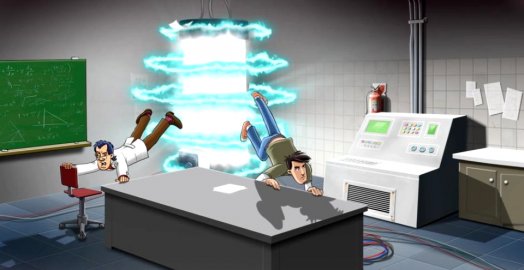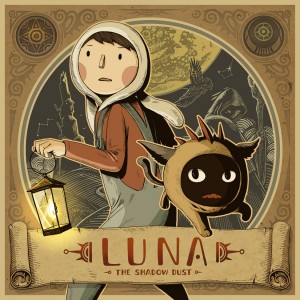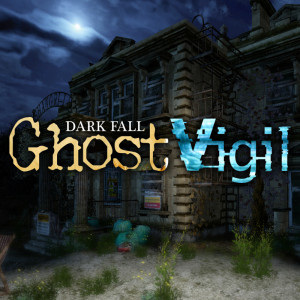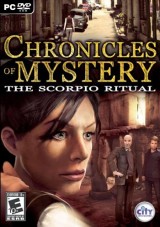Review for Reversion: Chapter 3 – The Return

As its name suggests, Reversion: The Return is not meant to be a standalone game but the latest sequel in a series dating all the way back to 2012. While the game begins with a recap of prior events in case your memory is a bit fuzzy on what happened, as the third installment in this episodic adventure from indie Argentinian studio 3f Interactivo, you really need to have played the first two games to make sure you are up to speed. At the end of the previous chapter, The Meeting, you finally got to meet the person in the half-photo you have been carrying around and even learn who you are. While the pace of the earlier episodes was relatively slow, at last the story takes off in this much more substantial third chapter, even if some of the otherwise engaging puzzles are a bit of a slog in your effort to see things through to the end.
When the story resumes, the protagonist, Christian, finds himself in a hidden laboratory with the professor and Victoria. You discover that the professor’s name is Nicolás and, in the form of a flashback, learn that he and Christian were colleagues in developing a teleportation device. When trying to test that device, something went horribly wrong. The result was the devastation of Buenos Aires that we saw at the beginning of the series, caused by a wormhole that resulted in a time shift. This explains why Christian thought the year was 2015 when it is actually 2035, and why Nicolás looks older. It turns out that someone sabotaged the machine, but who and why? As the player, your job is now to figure that out and hopefully reverse what happened. But it will not be easy, and you will need the help of several characters to get the job done.
In terms of graphics, sound and gameplay, nothing has changed significantly from previous outings. The hand-drawn characters and backgrounds are charming, cartoony but with just the right amount of detail. As before, the background music changes to suit your environment, but it repeats frequently so if you linger in any one location it can become quite annoying. The voice acting for the main character Christian remains okay, but most of the other performances are barely acceptable. In particular, Nicolás (your science partner and mentor) sounds like a bad Bernie Sanders impersonation, and Victoria just sounds bored and disengaged. While I can appreciate that the game was originally developed for a Spanish audience and there was likely only a small budget for English localization, I expected better quality from such an otherwise polished production.
When you begin to explore both familiar and new locations, you’ll see that the point-and-click interface and gameplay remain largely unchanged as well. Movement and interaction are the same, including the rather clunky need to double-click hotspots to call up a small interaction menu. Even some of the inventory items you possessed at the end of the last game are still here for use later on. It’s worth highlighting that a manual save system is once again used, with a generous number of slots available. This is refreshing since most modern adventures use an automatic checkpoint system, though you’ll need to remember to record your progress before quitting the game.
While the inventory is also similar, at one point you need to rotate an item shown in close-up to reveal something hidden at the back. This came out of the blue and I had trouble figuring it out, since to that point it had been not possible to do so with anything else. Also, normally to use an acquired object on something in a scene, you select it from inventory and then click on the environmental object you think is the right one. But several times you need to change clothes, and to do that you need to double-click on the appropriate inventory item and select the “hand” icon. This is another inconsistency that took me by surprise, but once I knew what to do it was not a problem for the rest of the game.
The puzzles in The Return are varied and plentiful, and for the most part are fun to solve. Almost all of them are inventory-based, but there are other types as well, some of them quite clever. My favourite was having to examine different graffiti drawings that corresponded with how to configure a lock pick to open several doors in the same area. There are a few minigames as well; one is of a Concentration-style tile-matching variety but with limited tiles to match, and the other is a whack-a-mole game you need to play more than once. Neither is difficult, but I question the need to include an arcade-style task in what is otherwise a very traditional adventure game.
Usually the puzzles are well-clued, and in certain cases you are just told what to do, but some of them are real head-scratchers. For example, twice you must give an item to a particular character, but there is no indication I could find that you need to do so. Since there are a lot of objects to collect and people to talk to, you really can’t use the “try everything on everything” approach, so a clue when examining such items would have been very useful. The final puzzle is another example of clues being so subtle that it is difficult to figure out what to do. Fortunately, there are relatively few combinations possible for this one, so the brute force method can be used.
Then there are a number of conversation-based puzzles to tackle, and these verbal fetch quests represent one of my major gripes. You talk to one person to find out something about another character or puzzle element, then go to that person and work through the dialog choices to get another piece of the puzzle, then back to the original character or a new one, and so on. This can go on and on for some time and requires a tremendous amount of back and forth, which gets quite tedious. Although you can quickly get to each location using your GPS map and each area is relatively small, the number of trips back and forth is excessive, and the fun factor goes down in a hurry.
There is a built-in hotspot finder and hint system that you can click whenever you get stuck, but as in previous episodes, each time you request a hint you have to wait a little bit longer to get the next one. In most cases I found this feature useful to give me a nudge in the right direction, but on a few occasions it would tell me the obvious but offer no help in how to do it, so it was a little frustrating.
As the story progresses, there are several new characters to interact with and new areas to explore. Sometimes the additions appear in existing locations, while other times you will find them in an original spot on your GPS. Certain people prove to be part of the resistance to the paramilitary control that Buenos Aires is now under and can be a big help, while others simply exist as part of puzzles to be solved. The latter include an elephant, a monkey, a carnival guy, the Tango Guys dance team, a painter, and more. Of particular note is Valencia, who is mentioned by Nicolás as being involved in the resistance, but he is reluctant to talk more about her. Very suspicious!
New locations to visit include a zoo, the upper level of the engineering school, your home, a street museum and an alley located in La Boca, the docks of Puerto Madero, a prison, and ultimately the evil dictator Sergio’s communications center. Some are real locations in Buenos Aries, and the variety is refreshing, making the game feel less claustrophobic than earlier entries.
Without giving too much away, as you progress you will learn the nature of the sinister plot that Sergio is hatching, the identity of the teleportation machine saboteur, and a way to reverse the effects of the disaster caused 20 years before. Advances in the plot often trigger cutscenes that are well done. Of particular note are the scenes at Casa Rosada, which houses an underground jail. Here the Homeless Man (whom you met earlier) shows up looking just like Obi-Wan Kenobi, complete with tunic and apparent mystical powers – very funny!
While the first two chapters of this series were quite short and light on gameplay, this third installment of Reversion will provide a solid 4-6 hours of adventuring depending on how much back and forth you need to do in order to solve some of the more meandering puzzles, though the overall path is very linear. As a finale (the series having been reduced from the original six planned episodes to only three), The Return finishes with a tidy round-up of loose ends introduced up till now, so some of the unnecessary padding can be forgiven along the way to a satisfying conclusion. And be sure to stay tuned during the end-game credits for a teaser of what may be yet to come.


























__small.jpg)

